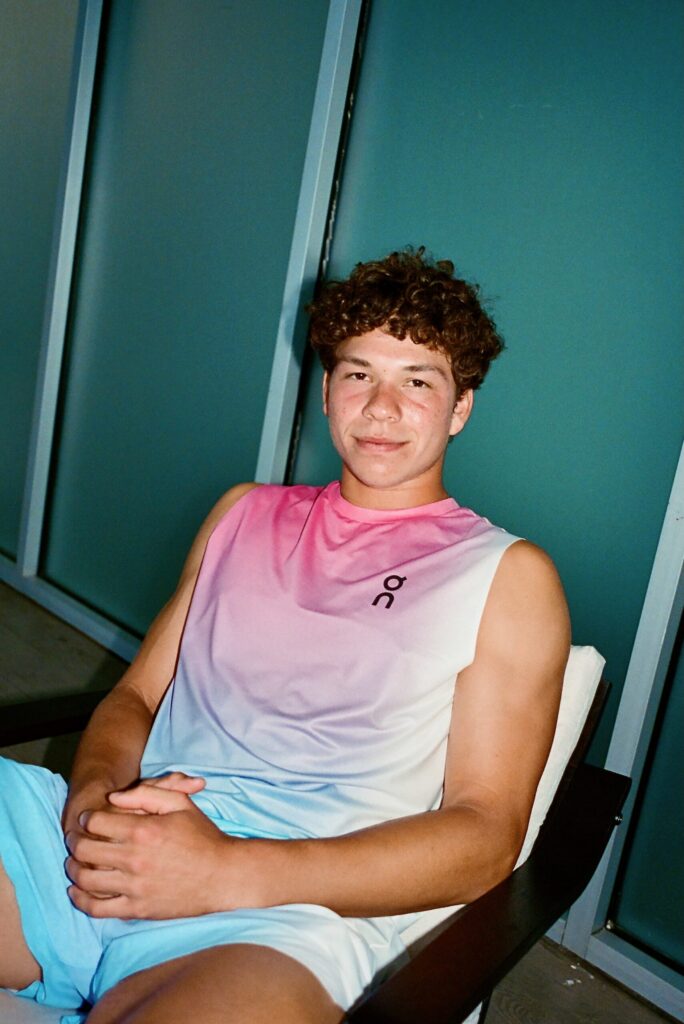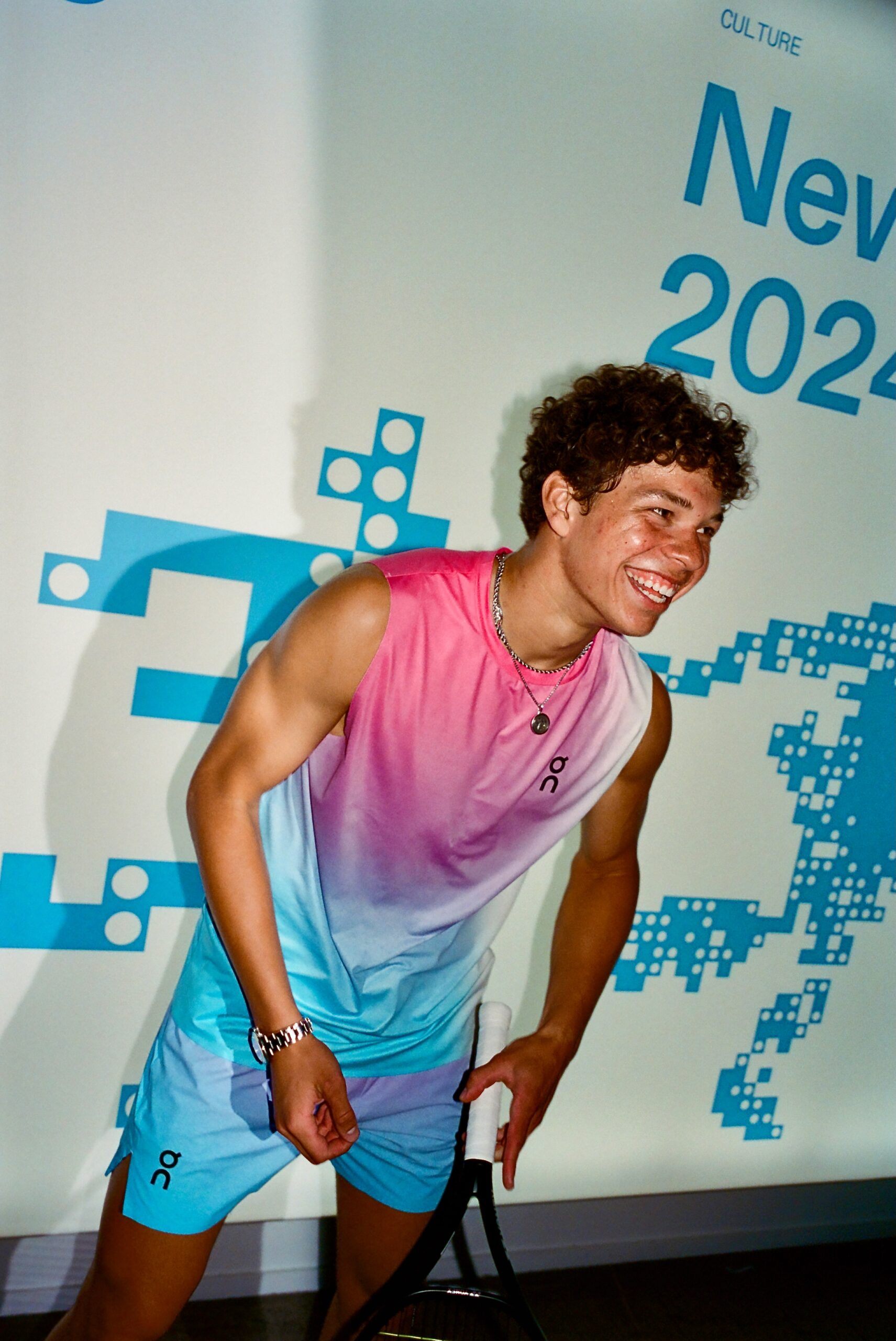Last week, in the quiet, upstairs green room of a giant Brooklyn field house that the Swiss sportswear brand On had transformed into a swanky tennis arena for its pre-US Open fête, Clubhouse Nights, 21-year-old Ben Shelton appeared buoyant and relaxed, as if he’d come home after eight months on the grueling, singularly intercontinental professional tennis circuit. Shelton, the 13th-ranked player in the world, is from Atlanta, but he seems unusually well-adjusted to the clamor of New York, where last year he enjoyed a breakout run to the semifinals of the U.S. Open, announcing himself as the Next Big Thing in American men’s tennis (and launching the sport’s coolest victory celebration in the process). At six-foot-four, with one of the biggest serves in tennis, Shelton embodies the kind of fratty energy seen more often on the verdant campuses of American state schools. But in person, he’s less swaggering than he is boyish, bearing the wide-eyed smile of a young man enjoying the limelight—and the coveted endorsement of Roger Federer. Before kicking off the year’s final Major, Shelton gave us exactly seven minutes of his time to talk Challengers and the state of American tennis. Then, he helped us assemble the perfect tennis player, in the aggregate.
———
JAKE NEVINS: Welcome back to New York.
BEN SHELTON: Thanks.
NEVINS: How does it feel coming back after last year’s breakout run?
SHELTON: I feel good, man. I think that I’ve grown a lot in the past year, and learned a lot of things. I feel like some of my best tennis is starting to come out. I know that I’m not a complete product, and I have a lot of things that I’m still working on every day, but I like where I’m at right now coming to the US Open.
NEVINS: It seems like you’re rounding into form at the right time. You had a really good week in Cincinnati. But I know this year has had its ups and downs. The tennis commentariat likes to anoint young prodigies prematurely, and that was you at the Open last year. What’s been the toughest challenge in the 12 months since?
SHELTON: Yeah, I think in tennis you have plenty of setbacks, plenty of times where you’re not the one winning or doing well. And that’s part of learning and part of finding ways to improve. Nothing good comes easy. I had a period of time in between the US Open and the Australian Open where I struggled a lot. And there were some similar times this year—not quite as much struggle, but I underperformed in areas where I thought I could do better. And I think those are the moments where you’re able to improve and find that extra 1% that you want to get better.
NEVINS: It’s been 21 years since an American man won a major, but there’s five of you in the top 20. How do you handle that pressure, ‘cause there will be a lot of noise these next two weeks.
SHELTON: Yeah, for sure. Every time that I go out there, I’m playing for my country. I have the American flag on my chest, not literally, but I’m just excited about where American tennis is at. I’m not sure who’s going to be the next guy to win a slam. But I am sure that there is going to be somebody in the future, an American, who wins a slam, and I think that we’re steadily improving. We went from one to two to three to four to five guys in the top 20 in a short time. So for me, it’s really encouraging. And the competitiveness is the best part of it. We’re all pushing each other. Since I’ve pushed into the top 20, top 15, I’ve seen other guys come through. And the more that each of us improves, the better we’re going to be as a group.
NEVINS: You’re at career-high right now, right?
SHELTON: Yeah. 13.
NEVINS: Hell yeah.
SHELTON: Not bad.
NEVINS: Not bad at all. Let’s switch gears. Have you seen Challengers?
SHELTON: I have seen Challengers.
NEVINS: What did you think?
SHELTON: I mean, I wasn’t the biggest fan of the movie, to be honest. I thought that the tennis part, they did a great job with that.
NEVINS: Go on.
SHELTON: The guy’s technique, the way that the ball was moving, it all looked real. I liked the concept of it, but I didn’t really understand the plot.
NEVINS: What didn’t you understand?
SHELTON: For me, it was like… Zendaya is in a love triangle with two guys. But even the ending—I mean, the match never finished. Whatever happened at the end was kind of strange. They just jumped into each other’s arms. Right?
NEVINS: Yeah.
SHELTON: So I’d say that part, for me, I didn’t understand as much. But I liked the idea of it, and I liked that a lot of people liked it.
NEVINS: They did. I get emails like, “Searches for tennis lessons rise by 500%.” I don’t know how much Challengers has to do with that, but that’s a nice byproduct of the movie.
SHELTON: For sure.
NEVINS: These guys are going to cut me off, so I’m going to finish with something fun. I want you to build your ideal composite tennis player: serve, forehand, backhand, etc.
SHELTON: Okay. Serve, because for me he’s the greatest normal-sized server of all time, I’ll take Federer.
NEVINS: Right. Forehand?
SHELTON: I’m going to take Nadal’s forehand. I’m going to take Djokovic’s backhand and his return serve.
NEVINS: Wise.
SHELTON: I’m going to take Stefan Edberg’s volleys.
NEVINS: Oh, okay. He’s before your time.
SHELTON: He is. I’ll take Pete Sampras’ overhead and athleticism.
NEVINS: Okay. What about intangibles?
SHELTON: Wait. Movement, I might take Alcaraz.
NEVINS: Word.
SHELTON: And mentality, I’m going to go Rafa for sure. There’s so many little niche parts of tennis where you could take different guys, but I’d say those are my main categories.
NEVINS: That’s an unbeatable player you’ve put together. Good luck next week.
SHELTON: Yeah, for sure. Appreciate it.


